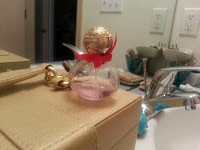It’s that time again…another chance to take a look at the
past year and think about what we can do better. There are many ways to improve
your health that don’t include going to the gym or changing your diet (although
those are great healthy actions to take!).
10 New Year’s resolutions to improve your health:
 1. Wash your hands better and more often. Washing hands often and well is one of
the healthiest actions you can take. We all know to wash hands after using the
restroom and before eating but what about after getting home from work (no
matter what your job is) the grocery store, getting gas, touching an ATM
receipt? A thorough job involves getting between fingers, under rings, and
under nails. Hand washing reduces the spread of illnesses and reduces exposure to toxic chemicals. Dirt and dust contain tiny
particles of toxic chemicals, washing your hands often will help reduce the
amount that get into your body.
1. Wash your hands better and more often. Washing hands often and well is one of
the healthiest actions you can take. We all know to wash hands after using the
restroom and before eating but what about after getting home from work (no
matter what your job is) the grocery store, getting gas, touching an ATM
receipt? A thorough job involves getting between fingers, under rings, and
under nails. Hand washing reduces the spread of illnesses and reduces exposure to toxic chemicals. Dirt and dust contain tiny
particles of toxic chemicals, washing your hands often will help reduce the
amount that get into your body. 2. Make the switch to
non-toxic cleaners. This resolution can save you money if you make
your own green cleaners and reduce your exposure to toxic chemicals. It’s
win-win!
2. Make the switch to
non-toxic cleaners. This resolution can save you money if you make
your own green cleaners and reduce your exposure to toxic chemicals. It’s
win-win! 3. Take off your shoes before entering your home. This simple action can improve indoor air quality and reduce your exposure to toxic chemicals. If you already have a “No shoes inside” rule, re-commit to it and enforce it better.
 4. Make your lawn
pesticide-free by committing to natural lawn care. Using bug and weed killers can allow
for toxic chemicals to be tracked into your home and vehicle(s). This can also
harm pets and wildlife and contaminate our water ways, including our drinking
water.
4. Make your lawn
pesticide-free by committing to natural lawn care. Using bug and weed killers can allow
for toxic chemicals to be tracked into your home and vehicle(s). This can also
harm pets and wildlife and contaminate our water ways, including our drinking
water. 5. Take your unwanted, unused household hazardous products to HazoHouse for free, safe disposal. Do you have an extremely cluttered garage or shed? Perhaps tackle one area at a time and make sure you dispose and store household hazardous products safely.
6. Recycle your used motor oil. This is a free easy way to keep motor oil out of our environment and to reduce your carbon footprint. You also reduce your carbon footprint when you purchase recycled (re-refined) oil or request it when you get your oil changed.
7. Re-commit to caring for your septic system. Sometimes we forget that our septic systems need special attention just like any other large expensive piece of equipment. Inspect it or if you know it’s time - Get it pumped!

8. Make the switch to safer personal care products. Many personal care products such as shampoo, soap, lotions and cosmetics contain chemicals that are linked to health effects such as cancer, reproductive issues, obesity, and more. As you use up your current products, replace them with safer products. A great resource for researching products is www.cosmeticsdatabase.com. If you would like information on this topic, call (360) 867-2579.
9. Phase out the use of scented products in your home to improve indoor air quality. Scented products such as air freshener sprays, scented plug-ins, and candles can send toxic chemicals such as phthalates into your indoor air. Instead of using these products, try opening a window for fresh air, find the source of the bad smell and get rid of it or simmer cinnamon sticks and water on the stove for fifteen minutes.
 10. Step up your dust
control. Dust
can contain some pretty nasty stuff such as pesticides, toxic flame retardants
and even heavy metals like lead and arsenic. Reduce your family’s exposure by
vacuuming and dusting with a water-dampened cloth more often.
10. Step up your dust
control. Dust
can contain some pretty nasty stuff such as pesticides, toxic flame retardants
and even heavy metals like lead and arsenic. Reduce your family’s exposure by
vacuuming and dusting with a water-dampened cloth more often.
It's true that regular exercise and eating right are key components
to being healthy, but remember we also need a healthy living environment.
Whatever your 2014 New Year’s goals are, best of luck! Happy and Healthy New Year to all!
Whatever your 2014 New Year’s goals are, best of luck! Happy and Healthy New Year to all!







